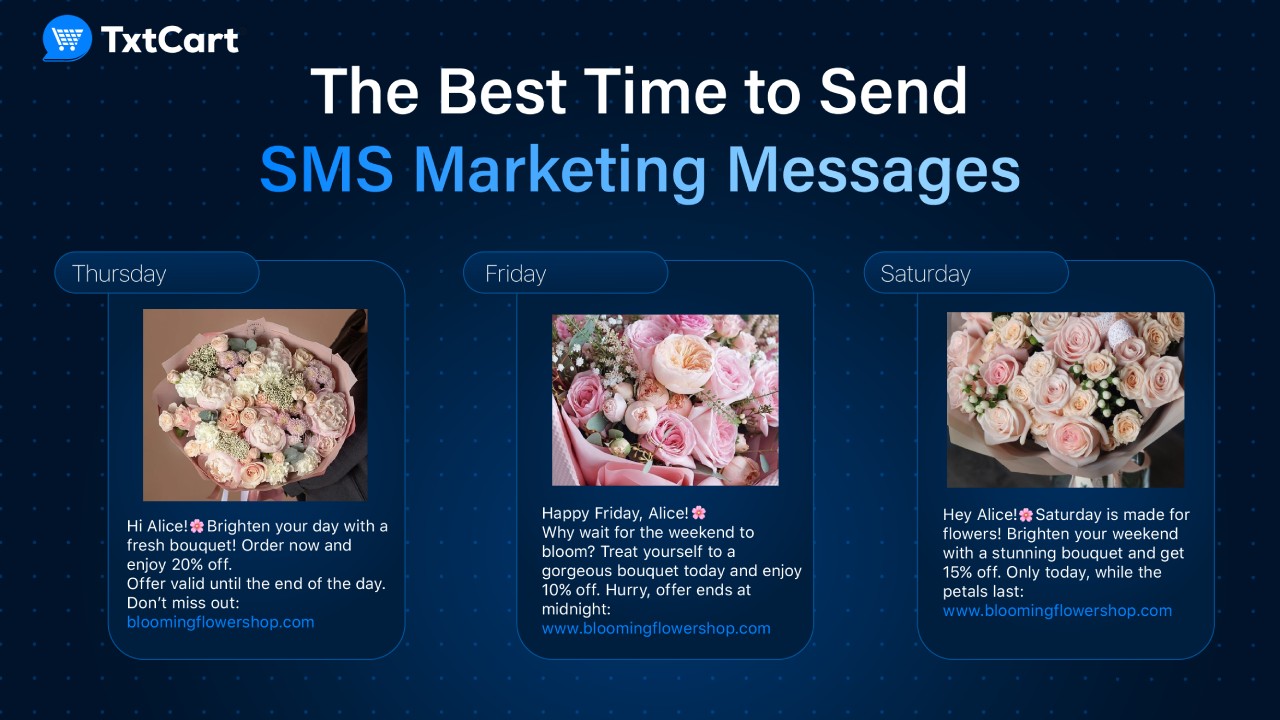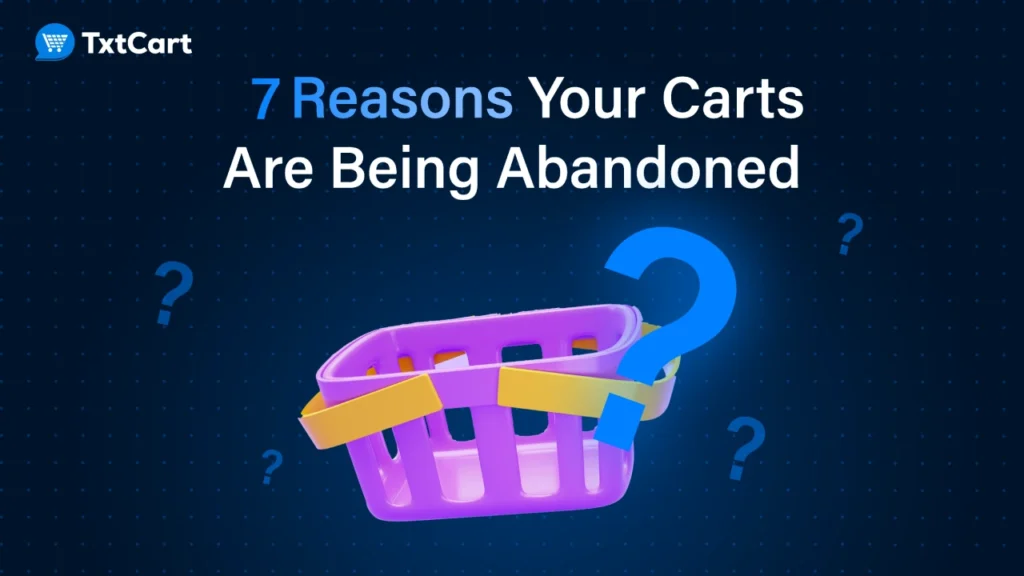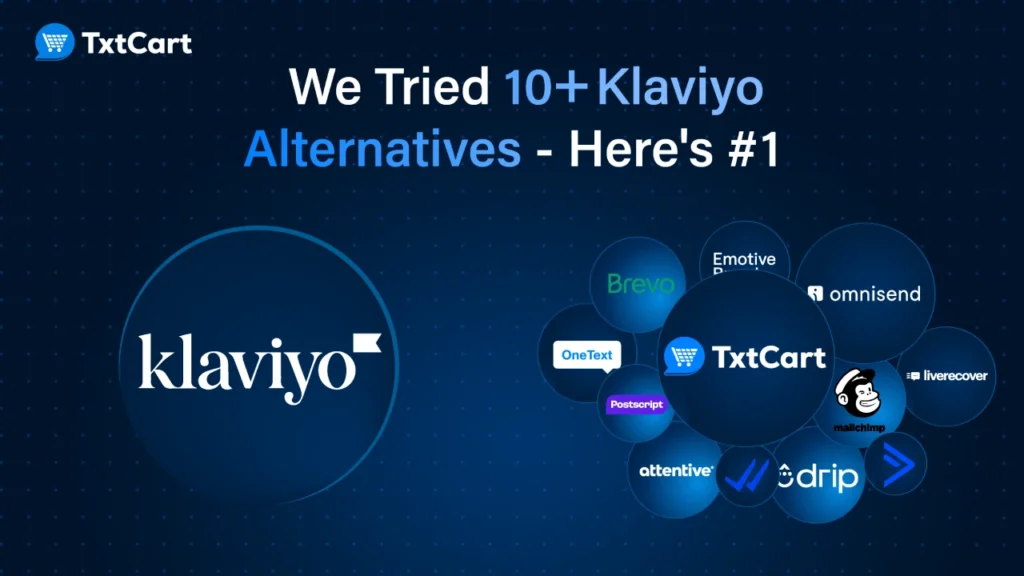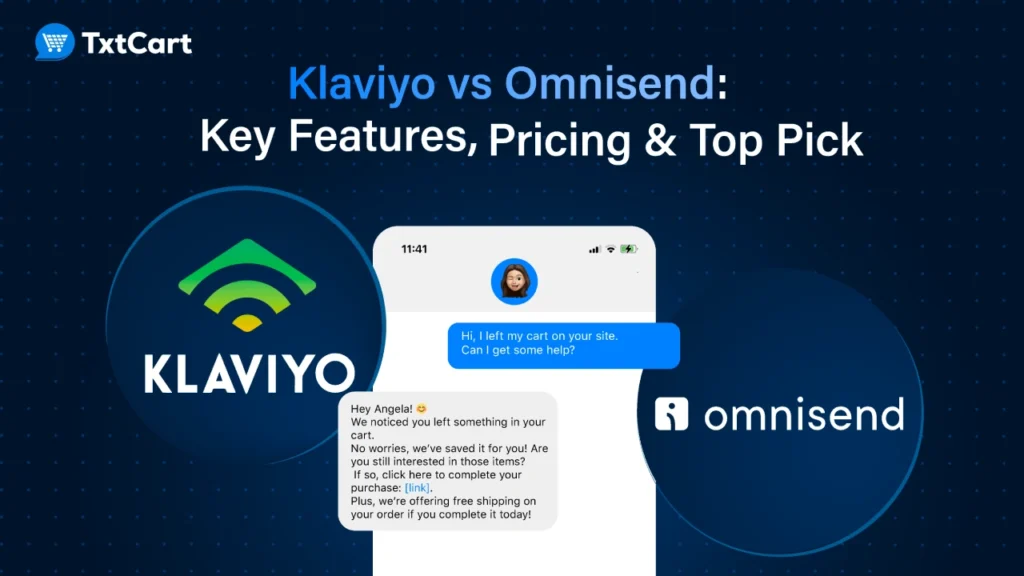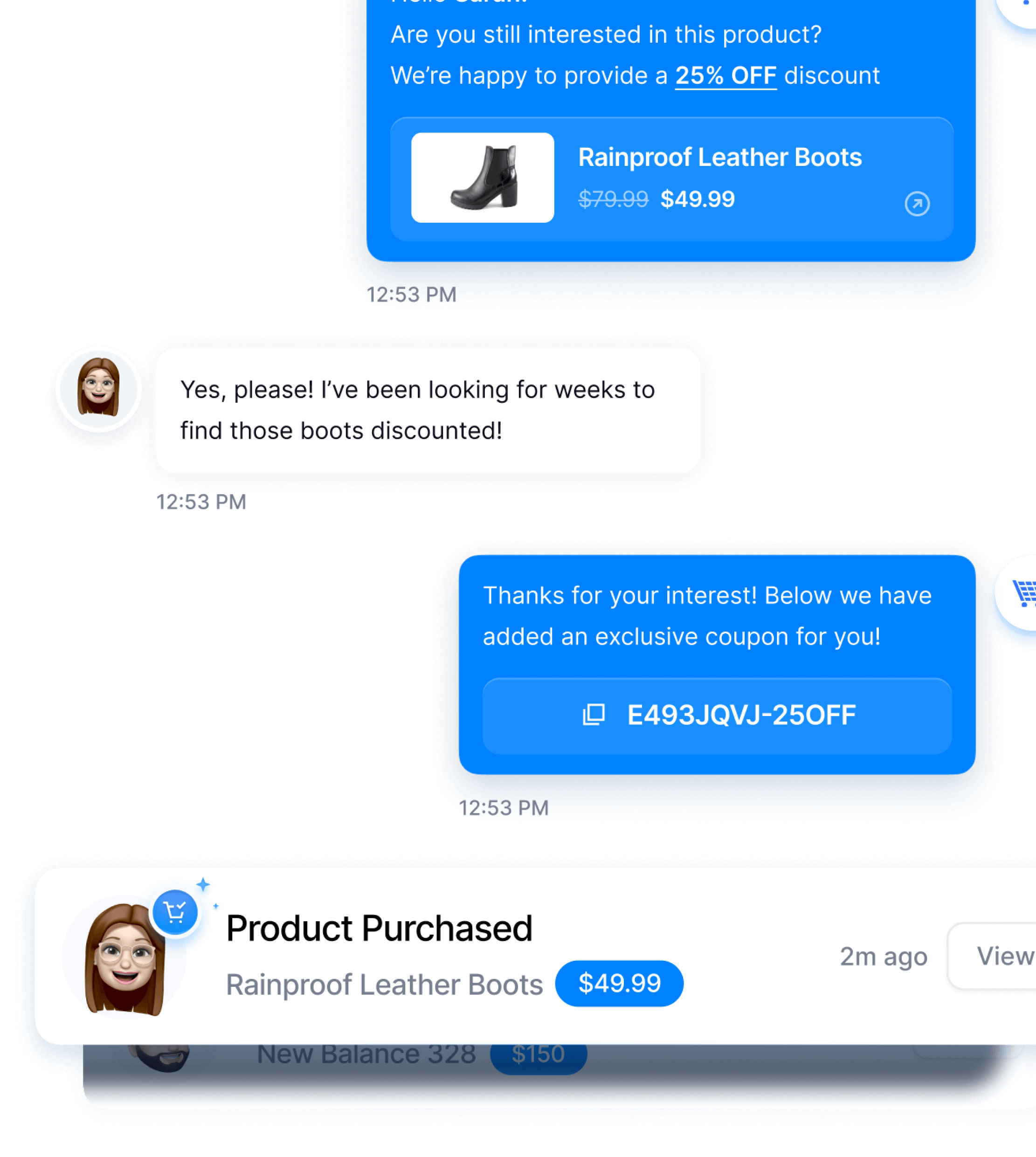When’s the perfect moment to hit “send” on an SMS campaign? Timing is crucial. The wrong time could lead to missed sales—or worse, an unsubscribe. It’s not just about when you send but how your timing aligns with your customer’s daily routine, habits, and mood. In this guide, we provide data-driven insights for 2025 to help you maximize engagement without annoying your audience.
What You’ll Learn:
- Key timeframes for different SMS campaign types
- Seasonal timing tips to align with shopping trends
- The impact of personalized timing for better conversions
P.S. If you’re looking to make SMS sending easier and more hands-off while never missing a beat, TxtCart lets you send eerily human-like text messages to customers tailored to your schedule. Check out our Campaign Planner to streamline your SMS timing strategy.
TL;DR: Best Times to Send SMS Marketing Messages
- Peak sending windows: Data from thousands of stores shows 3 PM and 6 PM drive highest engagement. Mid-afternoon catches people on breaks, while early evening hits the post-work sweet spot.
- Best days for SMS: Thursday captures pre-weekend shopping momentum, while Sunday dominates online browsing. Avoid Mondays—they consistently show lowest engagement across industries.
- Your secret weapon: Send messages in subscribers’ local time zones, use personalized timing based on behavior, and let AI handle the optimization. TxtCart’s scheduler automates this for consistent results.
- Stay compliant effortlessly: TxtCart’s built-in compliance tools automatically respect quiet hours (8 PM-8 AM), manage opt-outs, and follow TCPA regulations—so you can focus on selling without worrying about violations.
What is SMS Marketing?
SMS marketing connects businesses to customers via text messages. With its high open rates and immediacy, SMS is perfect for time-sensitive messages like promotions, reminders, and abandoned cart alerts. However, consent is essential—customers must opt in to receive messages to comply with regulations like TCPA in the U.S. and GDPR in the EU. Compliance builds trust and ensures effectiveness.
Factors That Influence the Best Time to Send SMS Messages
The “best time” to send SMS varies by audience, campaign, and context. Here’s what to consider:
- Target Audience
- Young Professionals: Most active from 5–8 p.m. after work.
- Retirees: Respond well to mid-morning or early afternoon messages.
- Parents: Reachable during school hours or after bedtime.
- Time Zone Differences – Not all your subscribers are in the same place. You want to ensure they’re not getting hit with an untimely message. TxtCart’s campaign scheduler allows businesses to adjust send times for each subscriber’s time zone, ensuring relevance without interruptions.
- Purpose of the Message
- Promotions: Late afternoon or early evening aligns with shopping habits.
- Order Confirmations: Send immediately for reassurance.
- Reminders: A few hours post-engagement or just before the event works best.
- Industry/Niche Considerations
- Retail: Peaks during weekends and holiday seasons.
- Health & Wellness: Weekday mornings perform well.
- Dining & Entertainment: Best just before meals or weekends.
- Seasonal Timing & Campaigns – Launch campaigns early for holidays and seasonal events. For example:
- Black Friday: Thursday evening or Friday morning.
- Back-to-School: Late July through August, with weekend reminders.
Best Times to Send SMS Messages (Backed by Data)
Choosing the right time to send SMS messages can be the difference between a sale and silence. While there’s no one-size-fits-all approach, research-backed insights reveal some key trends.
At TxtCart, we’ve analyzed sending patterns across thousands of eCommerce brands, and combined with industry benchmarks; our data consistently shows optimal engagement windows. These times won’t guarantee results, but they’re based on patterns that consistently drive higher engagement, conversions, and revenue across industries.
Studies indicate that two primary time windows tend to generate the highest engagement rates:
- 3 PM: TxtCart data shows peak engagement during mid-afternoon when people take breaks
- 6 PM: Our highest-converting window, catching people as they finish their workday
These times align well with the natural rhythms of the day when people are typically most receptive to engaging with messages.
Alternate Peak Times Beyond the top-performing windows, a few other times have also proven effective across various studies:
- Mid-afternoon (around 2 p.m.): This post-lunch lull can be a good time to engage users during breaks or scroll through their phones.
- Post-Dinner (around 8-9 p.m.): Catching customers after dinner works well for some audiences, as they’re winding down for the day and may be more likely to shop or interact with brands.
Testing messages during these alternative times could lead to valuable engagement, especially for brands targeting consumers with varying routines.
Best Times by Day of the Week Analyzing data from thousands of eCommerce brands on TxtCart’s platform shows that the day of the week plays a significant role in campaign success:
- Thursday and Sunday: These days consistently yield the highest engagement and revenue per message across our client base. Thursday often marks the start of shopping momentum, while Sunday sees peak engagement for online shopping.
- Avoid Mondays: Mondays are typically low-engagement days for SMS, as people are busy catching up on work or resetting after the weekend. SMS campaigns sent on Mondays can easily be overlooked or dismissed as irrelevant in the context of a hectic start to the week.
Pro Tip: Send Slightly Off the Hour – For an extra boost, consider sending messages a few minutes before or after the hour—e.g., 10:18 a.m. or 12:43 p.m. Rather than sending right on the hour or half-hour, which can trigger spam filters and put your message alongside numerous others, slight deviations can improve deliverability and help your message stand out in a crowded inbox.
Leveraging TxtCart’s Campaign & Revenue Analytics
While general timing guidelines are helpful, nothing beats real-time data. TxtCart’s Campaign & Revenue Analytics provides brands with personalized insights on the best times to reach their audiences. This tool not only reveals which hours yield the highest engagement and revenue but also helps brands refine their SMS strategies over time.
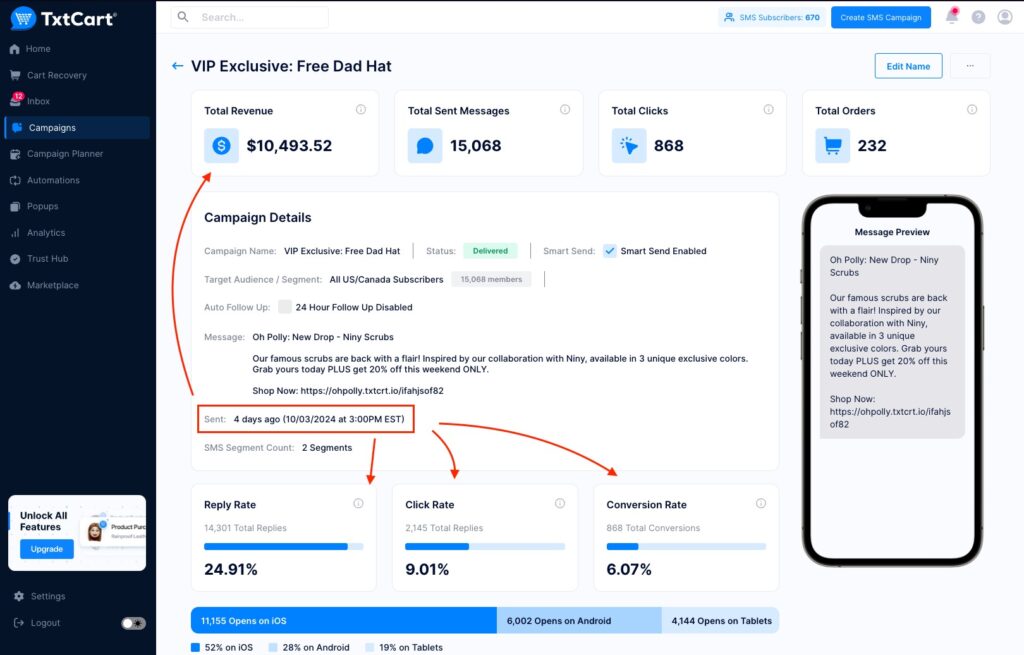
By reviewing each campaign’s performance, marketers can adjust send times based on actual user response, continually improving engagement and maximizing returns with data-driven adjustments.
Recommended Days for SMS Blasts
When planning SMS campaigns, the day of the week can have a big impact on how customers respond. While every audience is unique, certain days tend to show higher engagement and conversions across the board. Here’s a breakdown of the best, most effective days to send SMS blasts—and the ones you may want to skip.
Best Days for Engagement
- Thursday, Friday, and Saturday: These days consistently rank highest for SMS engagement. Thursday marks the start of the weekend anticipation, which often motivates customers to browse, consider new purchases, and check out promotional offers. Friday builds on this momentum as people wind down the workweek and make plans for the weekend, while Saturday captures the weekend shopper’s attention when they’re out and ready to make decisions.
High Conversion Days
- Saturday and Tuesday stand out as high-conversion days. Saturday excels across industries like retail and eCommerce, as relaxed customers are more willing to spend. Tuesday performs well because it avoids Monday’s busyness and the mid-week slump, making it ideal for time-sensitive promotions or limited offers. Testing campaigns on these days can boost results.
Worst Days for SMS Blasts
- Monday: Mondays generally rank the lowest for SMS effectiveness. At the start of the week, people are often focused on work and catching up on tasks, making them less receptive to marketing messages.
- Mid-week (Wednesday): By mid-week, engagement dips as people are deep into their routines. Wednesday tends to show lower open and conversion rates, with messages often glanced over or ignored altogether.
Timing Tips for Different Campaign Goals
The timing of your SMS campaigns depends on the goal of each message. Here’s a concise breakdown of optimal timing for different purposes:
Promotions
- Best Times: Noon and 6–8 p.m., when people are on lunch breaks or winding down.
- Why It Works: Aligns with daily routines, increasing the likelihood of engagement.
- Pro Tip: For limited-time offers, send a reminder near the campaign’s end to create urgency.
Conversion-Focused Messages
- Best Times: Early mornings (8–11 a.m.), when customers are focused and ready to act.
- Why It Works: Customers are more decisive in the morning, making it ideal for driving thoughtful purchases.
Abandoned Cart Reminders
- Best Timing: Send reminders within 24 hours of abandonment.
- Why It Works: Timely reminders encourage customers to return and complete purchases.
- Pro Tip: Use a two-step sequence—one reminder immediately, another within 24 hours—to boost conversions without overwhelming customers.
PS., TxtCart’s conversational SMS sends eerily human-like text messages in your SMS campaigns — whether for abandoned cart recovery, upsells, or even handling customer queries. Here’s an example of our AI in action:
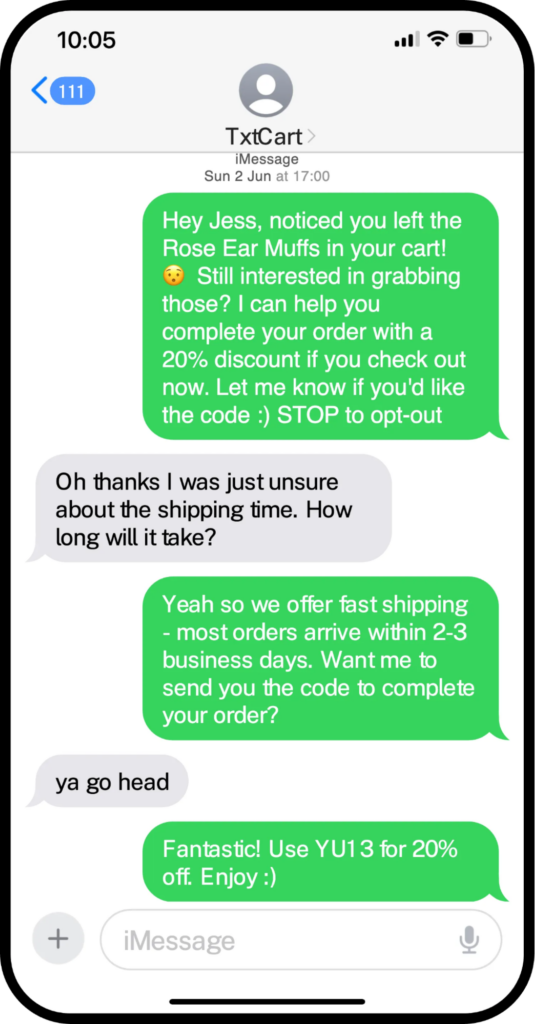
Holiday and Event Campaigns
- Best Timing: Send messages a few days before the event to avoid the last-minute rush.
- Why It Works: Early messages allow customers to plan purchases without pressure.
- Pro Tip: For holidays like Black Friday, send an early reminder and follow up closer to the date to capture last-minute buyers.
When Not to Send SMS Messages
Timing your SMS campaigns effectively can boost engagement, but poor timing may lead to unsubscribes.
- Avoid Late Nights/Early Mornings: Messages sent after 8 p.m. or before 9 a.m. can feel intrusive. Stick to 9 a.m.–8 p.m. for better reception.
- Mind Rush Hours/Holidays: Texts during 7–9 a.m., 4–6 p.m., or last-minute holiday campaigns may be ignored. Schedule messages a few days early and avoid commute times.
- Follow Quiet Hour Rules: Many regions ban texts from 8 p.m.–8 a.m., with penalties for violations. PS., TxtCart has built-in compliance, so you don’t have to worry about non-compliance risks.
Best Practices for SMS Marketing Timing
Optimizing the timing of your SMS marketing is essential to maximizing engagement and minimizing opt-outs. Here’s a set of best practices to help you fine-tune your SMS timing strategy for the best results.
1. Segmentation and Personalization
Not all customers respond the same way at the same time. By segmenting your audience, you can send messages tailored to specific groups based on preferences, location, and past behavior, significantly increasing relevance and engagement.
- Location-Based Segmentation: Segment customers by location to align messages with their time zone, regional events, or local buying trends.
- Behavioral Segmentation: Segment based on previous purchase history or browsing behavior. For instance, frequent buyers may appreciate early access to new promotions, while recent abandoners may benefit from immediate cart reminders.
- Personalized Content: Use personalization elements that align with timing, such as offering a “lunchtime deal” or “weekend special,” making the message feel more relevant.
By the way, TxtCart lets you filter audiences by purchase behavior, engagement levels, cart status, and contact history. Target specific groups like repeat buyers, abandoned carts, or inactive customers—with exact subscriber counts for each segment shown. Pro tip: Combine segments (like “abandoned cart + texted more than once”) to create hyper-targeted campaigns with higher engagement rates.
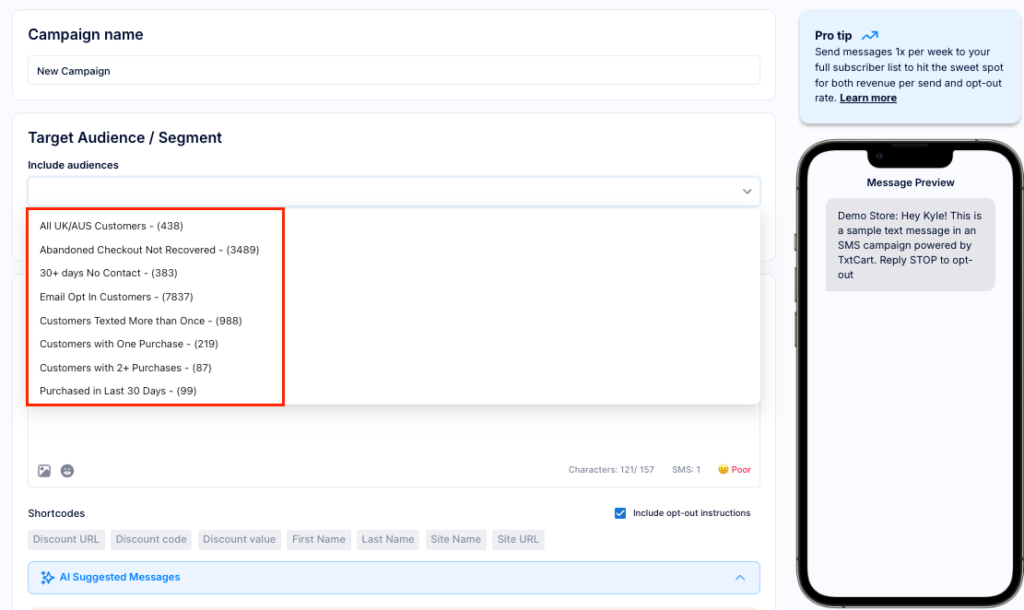
2. Time Zone Adjustment
Customers across different time zones need messages that align with their local time for the best response. Automated tools like TxtCart’s Scheduler can handle time zone alignment, ensuring that messages reach each customer at an ideal hour, no matter where they are. This feature is crucial for brands with a regional or global reach, helping to avoid early-morning or late-night sends that could result in customer annoyance.
3. A/B Testing
- Implementation: Start by sending two versions of a message at different times or with slight variations in content to separate segments of your audience. For example, send one message at 2 p.m. and another at 6 p.m., or test different call-to-action phrases.
- Metrics to Track: Monitor open rates, click-through rates, and conversions to see which version performs better. These insights will help you understand when your audience is most responsive and what messaging resonates with them.
- Iterative Testing: Don’t stop after one test. Repeat A/B tests periodically to keep refining your strategy, as customer preferences and behaviors can change over time. Regular testing ensures that your SMS campaigns remain effective and relevant.
TxtCart continually experiments and adjusts your SMS campaigns based on real-time data; you can personalize your messaging to meet your customers’ needs and preferences better, ultimately driving higher engagement and conversion rates.
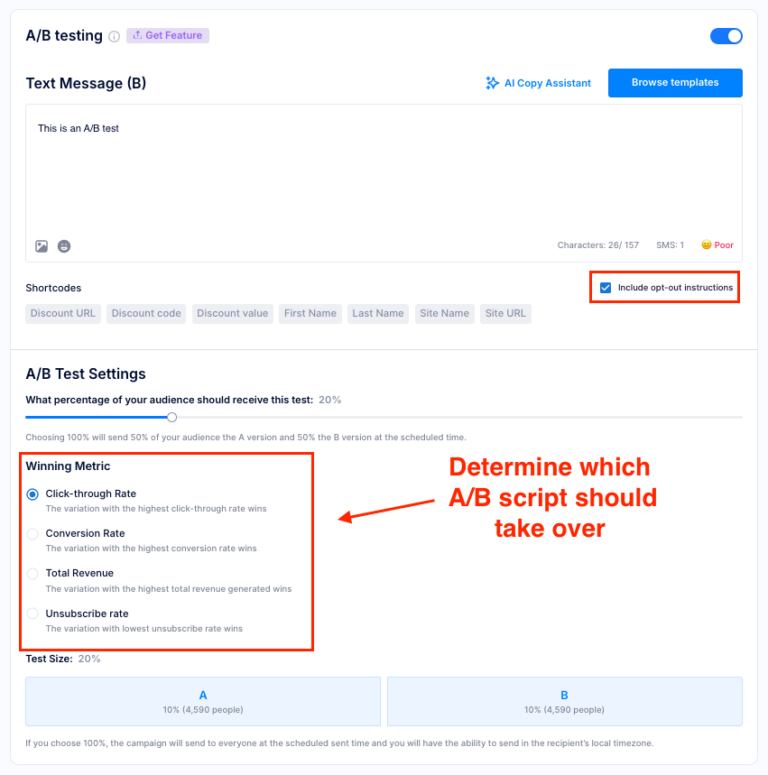
Read more: 15+ Text A/B Testing Examples to Boost Your SMS Marketing
4. Iterative Testing and Timing Strategy Adjustment
- Beyond A/B testing, multivariate testing and timing adjustments provide deeper insights into SMS effectiveness.
- Multivariate Testing: Test multiple variables (e.g., days and times) to identify the best timing for different audience segments. Unlike A/B testing, it reveals optimal combinations rather than comparing just two options.
- Analyzing Effectiveness: Regularly review data to refine timing strategies, adapting to seasonal trends, regional preferences, and audience growth. This approach maximizes engagement and reduces message fatigue over time when sending SMS.
5. Frequency Caution
Frequency is as important as timing. Sending too many messages risks opt-outs, so keep your frequency in check.
Best Practice: Limit SMS sends to 6–8 per month to ensure messages are valued and reduce opt-outs. Focus on high-value content around key events or promotions, avoiding unnecessary sends.
TxtCart’s AI Copy Assistant: This tool tailors SMS content to different times of day, adjusting tone and content for relevance. For example, “Start your day with a deal” works for mornings, while “Unwind with savings tonight” suits evenings. This personalization boosts engagement and ensures timely messaging.
How to Determine the Best Timing for Your Unique Audience
To find the best timing for SMS messages, tailor your strategy to audience behavior rather than relying on generic rules:
- Track Engagement: Analyze open rates, click-through rates, and conversions to identify peak engagement windows.
- Survey Subscribers: Poll your audience for their preferred message times to guide your choices.
- A/B Testing: Test different times and days over several weeks to determine what works best.
Pro Tip: Test one or two variables at a time to refine timing and content strategies for optimal results.
Maximize Your SMS Marketing With Perfect Timing
Sending SMS at the right moment can dramatically boost engagement and sales. Based on data from thousands of eCommerce brands using TxtCart, we’ve uncovered the optimal times to reach your customers.
Key findings to boost your SMS performance:
- Target peak engagement windows: Data shows 3 PM and 6 PM consistently drive the highest engagement and sales. The mid-afternoon break and end-of-workday sweet spots get your messages seen and acted on.
- Choose your days strategically: Thursday and Sunday emerge as conversion champions across industries. Thursday captures pre-weekend shopping momentum, while Sunday sees peak online browsing activity.
- Test and optimize: Every audience is unique. Use TxtCart’s campaign scheduler to test different times, track performance, and automatically send messages in your subscribers’ local time zones for maximum impact.
Ready to boost your SMS results? TxtCart’s AI-powered platform helps you hit these optimal sending times automatically while recovering abandoned carts and engaging customers with natural conversations. Plus, with our 10X ROI guarantee for qualifying stores (10K+ monthly visitors), you’re set up for success. Start optimizing your SMS timing today.
